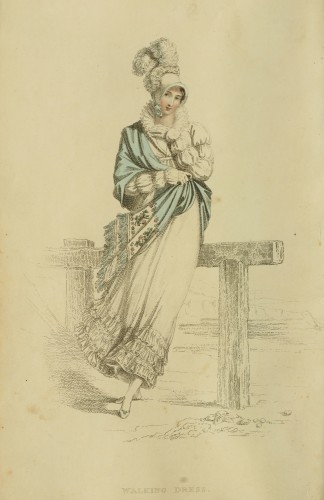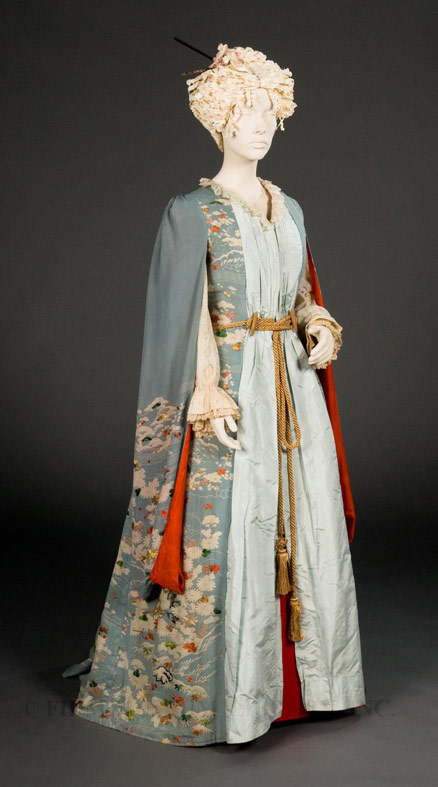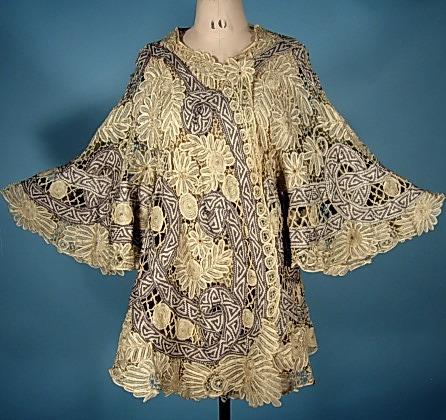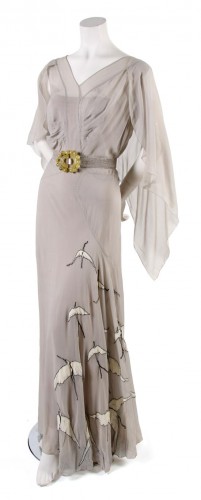The East has had a profound influence on Western fashions for millenia, from the Chinese silks that were worn in Ancient Rome (much to the dismay of the government, who hired notable writers to create anti-silk propaganda in order to discourage people from wearing it), through Vionnet, Lanvin, Chanel, and Schiapparelli: all the great designers of the 20s and 30s borrowed from the East.
There isn’t a single period that hasn’t borrowed from the East, and there isn’t a single Eastern culture that hasn’t been borrowed from. Islamic geometricism influenced Medieval and Renaissance textiles through the Crusades and the Venetian trade. Indian influence began in the 17th century when chintzes began to make their way to Europe, and florished again from the end of the 18th century when Kashmiri shawls introduced the paisley motif. The 18th century saw the fad for Chinoiserie, and the Turkish influence, and the late 19th century the rage for Japonisme.
Early 20th century fashion was influenced by every possible Eastern culture, from Poiret’s kimono inspired cocoon coats, to Orientalism of the Ballet Russes, to the Egyptomania that culminated around the discovery of Tutankhamen’s tomb.
In the Historical Sew Fortnighly challenge #14 (due July 15) make a historical garment that shows Eastern influence.
Orientalism is one of my favourite areas of historical costuming. I’ve made a 1780s Indian chintz inspired pet-en-l’aire, the 1813 Kashmiri dress, an 1850s paisley gown, an 1880s Japonisme gown, 1920s dresses and 1930s beach pajama tops from re-purposed kimono, and yet there are so many more Eastern inspired items I want to sew! Here are some of my favourite examples of Orientalism to get you started.
This 1740s robe à la française of Chinese silk which has been hand-painted in exotic flora just makes me swoon with delight. Finding a way to recreate it is high on my historical costuming bucket list!

Robe à la Française, 1740s, British, silk, pigment, linen, Metropolitan Museum of Art
Not just dresses showed the influence of chinoiserie in the 18th century, as this delicate Dutch fan attests:

Cut or decoupe fan, Dutch, About 1760—75, MFA Boston
And how can you not love this amazing blue and yellow parasol with chinoiserie handle?

Parasol in two parts (parasol) French, MFA Boston
I think my love of paisley and Kashmiri shawls is pretty well known! My latest favourite of the trend is this ensemble with a pale blue paisley shawl. And, of course, the dress itself might have been made of Indian muslin.

Ackermann’s fashion plate 4, Seaside walking Dress, 1815
In addition to the more typical paisley shawls, and paisley patterned cotton dresses, paisley also met traditional Western techniques, like broderie anglaise.

Petticoat, 1855—65, American, cotton, Metropolitan Museum of Art
While paisley was the most common Orientalist influence in the mid-19th century, there were exceptions. This simple dress with tone-on-tone Chinese roundels is both subtle and spectacular:

Dress, ca. 1850, British, silk, Metropolitan Museum of Art
One of the influences that 19th century fashion borrowed from Japan is the colours used in traditional kimono and ukiyo-e prints. The combination of muted blues and vivid vermillion in this furisode inspired dressing gown is a particularly spectacular example.

Furisode Kimono-Style Dressing Gown, c. 1885, Silk, FIDM Museum
Look at this amazing battenberg lace jacket, with the lace arranged in Japanese inspired designs. It’s such a beautiful and unusual interpretation of Japonisme.

Jacket of battenberg lace, ca 1905, Antique Dress
The most common form of Japonisme in the early 20th century, embraced by Poiret and a host of other designers, is the kimono based cocoon silhouette, seen in coats and dresses alike.

Opera coat House of Paquin (French, 1891—1956) Designer- Mme. Jeanne Paquin (French, 1869—1936), 1912, French, silk, Metropolitan Museum of Art
Paisley wasn’t the most common Eastern-inspired motif in the 1920s and 30s, but it wasn’t completely unknown. I own one length of 1930s paisley patterned cotton, and have seen two examples of ’30s paisley rayon. This paisley evening bag is just gorgeous:

Evening bag House of Lanvin (French, founded 1889) Designer- Jeanne Lanvin (French, 1867—1946), 1925—35, French, silk, metal, Metropolitan Museum of Art
Finally, I’m in love with this 1930s dress, with its nod to ukiyo-e aesthetic:

Day Dress, probably 1930s, bias cut with bird appliques along skirt, lesliehindman.com
For more inspiration, I’ve got a whole pinterest page of Orientalist fashions, and another of paisley in fashion.

Ooh, so much luscious inspiration on the Pinterest pages!
I’m sure I’ll be adding to it over the next few weeks too!
Oooooh, yay! I’m in love with eastern influence too! That 30’s dress is GORGEOUS!!!
So many beautiful things! I am charmed by the pale blue paisley shawl – not a colour I associate with paisley shawls, but so appropriate for the white and pastel muslin dresses of the time.
Oh wow! I would take a dressing gown, opera coat, and 30s dress like that! Just gorgeous!!!
There isn’t a single period that hasn’t borrowed from the East
It certainly appears to be true that the Viking period borrowed from the East. The caftan-like coat that shows up in the graves of Birka were based upon Eastern models, and the apron dress fragment found at Pskov is decorated with imported silk patterned in an Asian design.
Yes! I’ve read about Pskov find. It’s amazing how far textiles travelled.
I had a plan to make a Viking kaftan for By the Sea, but I won’t have time for it now. So I’m so happy about this challenge, because it gives me a second chance at that project!
Excellent! I’m pleased you’ll be able to make the item (if sad that you don’t have time to do it now).
Somewhere in my memory, why do I remember the Vikings controlling Kiev (I think) and really encouraging trade with the East? It’s amazing how little we respect history pre-1400 or so. (I know, 1066, 1104, etc–STILL!)
Because they totally did. I suspect it was accidental–they were probably working on a trade route system using the river network, one that might get them in touch with Byzantium, and hey! Local power vaccum! Can’t have that!
It’s so cool to know smart people. Thanks for the info!
My older sister is a research librarian–I’ve been marked for life as a result!
Oh my! So many questions! How did Opium culture affect fashion? What about the Boxer Rebellion? How do you separate the Orientalism of Said to the Orientalism of the far east? How did the colonisation of Souteast Asia affect fashion? The Dutch had Indonesia, but the British certainly had an interest in Thailand (Siam), which produces such beautiful things.
Also, could you possibly do a post on “Robe a la” ? What is the difference between anglaise, francais, polonais etc? Is there a confluence of fashion and politics there, too?
Do you have a take on the style in Hawaii of wearing traditional Japanese-style clothes to dictate that you are local-kine and Kama ‘Aina?
I made a cap with ear medallions and dangly tassels.
http://mouseborgdesigns.blogspot.ca/2013/07/an-orientalist-cap-c-1907.html
I’m so glad to have finally finished something early!
http://isabelladangelo.blogspot.com/2013/07/historical-fortnight-14-eastern.html
I created a nice new Turkish outfit as was worn in Italy in the 16th Century. It’s very comfy and I’ll have better pictures next week. But it is done!
A week late, but here is my entry for this challenge – a 1930s dress made from a Japanese-inspired fabric
http://blacktulipsewing.blogspot.co.uk/search/label/Mikko%20dress
My Sari Gown…finished at last! http://livingwithjane.blogspot.com/2013/07/historical-sew-fortnightly-challenge-14.html
I sewed a 1920 Fortuny Delphos Gown.
http://teacupsamongthefabric.blogspot.com/2013/07/1920-fortuny-delphos-gown-eastern.html
Laurie
I’ve moved my blog. This is the new location for my 1920’s Fortuny delphos gown.
http://teacupsinthegarden.blogspot.com/2013/07/recreating-fortuny-delphos-gown.html